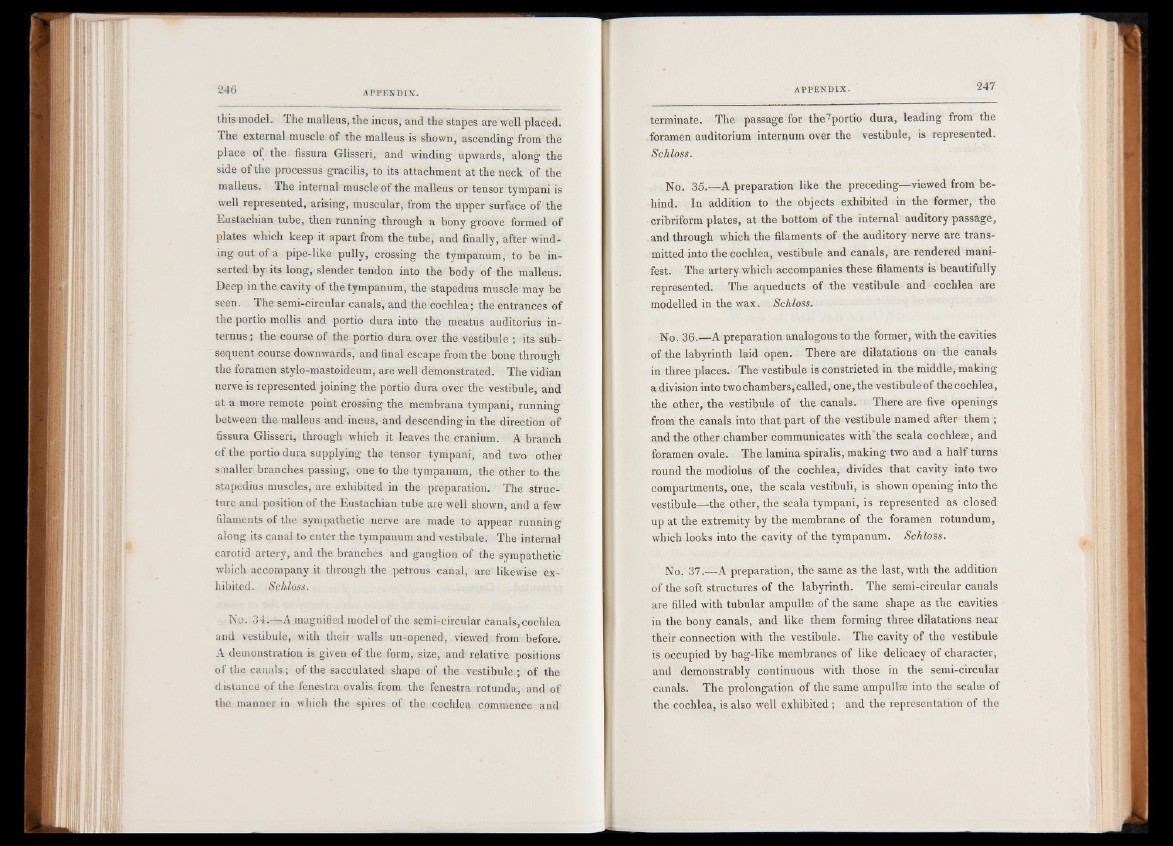
this model. The malleus, the incus, and the stapes are well placed.
The external muscle of the malleus is shown, ascending from the
place of the fissura Glisseri, and winding upwards, along the
side of the processus gracilis, to its attachment at the neck of the
malleus. The internal muscle of the malleus or tensor tympani is
well represented, arising, muscular, from the upper surface of the
Eustachian tube, then running through a bony groove formed of
plates which keep it apart from the tube, and finally, after winding
out of a pipe-like pully, crossing the tympanum, to be inserted
by its long, slender tendon into the body of the malleus.
Deep in the cavity of the tympanum, the stapedius muscle may be
seen. The semi-circular canals, and the cochlea; the entrances of
the portio mollis and portio dura into the meatus auditorius in-
ternus; the course of the portio dura over the vestibule ; its subsequent
course downwards, and final escape from the bone through
the foramen stylo-mastoideum, are well demonstrated. The vidian
nerve is represented joining the portio dura over the vestibule, and
at a more remote point crossing the membrana tympani, running
between the malleus and incus, and descending in the direction of
fissura Glisseri, through which it leaves the cranium. A branch
of the portio dura supplying the tensor tympani, and two other
smaller branches passing, one to the tympanum, the other to the
Stapedius muscles, are exhibited in the preparation. The structure
and position of the Eustachian tube are well shown, and a few
filaments of the sympathetic nerve are made to appear running
along its canal to enter the tympanum and vestibule. The internal
carotid artery, and the branches and ganglion of the sympathetic
which accompany it through the petrous canal, are likewise exhibited.
Schloss.
■ No. 34.—A magnified model of the semi-circular canals,cochlea
and vestibule, with their walls un-opened,. viewed from before.
A demonstration is given of the form, size, and relative positions
of the canals; of the sacculated shape of the vestibule ; of the
distance of the fenestra ovalis from the fenestra rotunda, and of
the manner in which the spires of the cochlea commence and
terminate. The passage for the7portio dura, leading from the
foramen auditorium internum over the vestibule, is represented.
Schloss.
No. 35.—A preparation like the preceding—viewed from behind.
In addition to the objects exhibited in the former, the
cribriform plates, at the bottom of the internal auditory passage,
and through which the filaments of the auditory nerve are transmitted
into the cochlea, vestibule and canals, are rendered manifest.
The artery which accompanies these filaments is beautifully
represented. The aqueducts of the vestibule and cochlea are
modelled in the wax. Schloss.
No. 36.—A preparation analogous to the former, with the cavities
of the labyrinth laid open. There are dilatations on the canals
in three places. The vestibule is constricted in the middle, making
a division into two chambers, called, one, the vestibule of the cochlea,
the other, the vestibule of the canals. There are five openings
from the canals into that part of the vestibule named after them ;
and the other chamber communicates with'the scala cochleae, and
foramen ovale. The lamina spiralis, making two and a half turns
round the modiolus of the cochlea, divides that cavity into two
compartments, one, the scala vestibuli, is shown opening into the
vestibule—the other, the scala tympani, is represented as closed
up at the extremity by the membrane of the foramen rotundum,
which looks into the cavity of the tympanum. Schloss.
No. 3 7 .—A preparation, the same as the last, with the addition
of the soft structures of the labyrinth. The semi-circular canals
are filled with tubular ampullae of the same shape as the cavities
in the bony canals, and like them forming three dilatations near
their connection with the vestibule. The cavity of the vestibule
is occupied by bag-like membranes of like delicacy of character,
and demonstrably continuous with those in the semi-circular
canals. The prolongation of the same ampullae into the scalae of
the cochlea, is also well exhibited ; and the representation of the